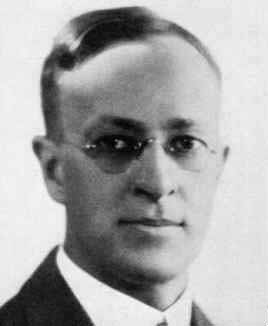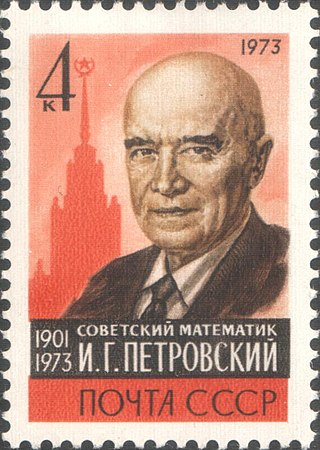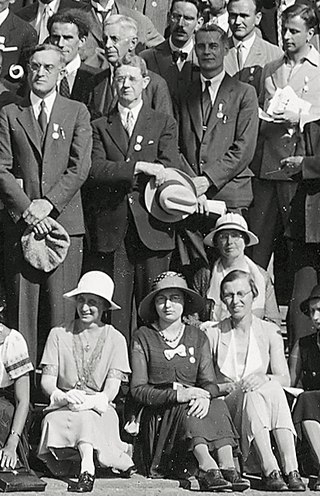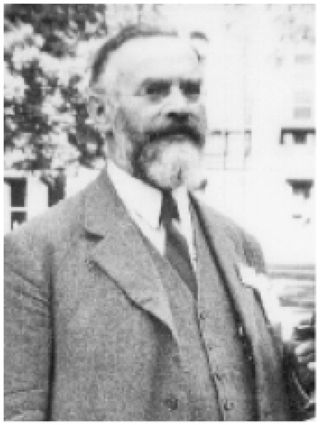
Jesse Douglas was an American mathematician and Fields Medalist known for his general solution to Plateau's problem.

Harold Calvin Marston Morse was an American mathematician best known for his work on the calculus of variations in the large, a subject where he introduced the technique of differential topology now known as Morse theory. The Morse–Palais lemma, one of the key results in Morse theory, is named after him, as is the Thue–Morse sequence, an infinite binary sequence with many applications.

Hans Hahn was an Austrian mathematician and philosopher who made contributions to functional analysis, topology, set theory, the calculus of variations, real analysis, and order theory. In philosophy he was among the main logical positivists of the Vienna Circle.
In mathematics, and particularly in potential theory, Dirichlet's principle is the assumption that the minimizer of a certain energy functional is a solution to Poisson's equation.

Eliakim Hastings Moore, usually cited as E. H. Moore or E. Hastings Moore, was an American mathematician.

Hans Lewy was an American mathematician, known for his work on partial differential equations and on the theory of functions of several complex variables.

Vojtěch Jarník was a Czech mathematician. He worked for many years as a professor and administrator at Charles University, and helped found the Czechoslovak Academy of Sciences. He is the namesake of Jarník's algorithm for minimum spanning trees.
Hilbert's nineteenth problem is one of the 23 Hilbert problems, set out in a list compiled by David Hilbert in 1900. It asks whether the solutions of regular problems in the calculus of variations are always analytic. Informally, and perhaps less directly, since Hilbert's concept of a "regular variational problem" identifies this precisely as a variational problem whose Euler–Lagrange equation is an elliptic partial differential equation with analytic coefficients, Hilbert's nineteenth problem, despite its seemingly technical statement, simply asks whether, in this class of partial differential equations, any solution inherits the relatively simple and well understood property of being an analytic function from the equation it satisfies. Hilbert's nineteenth problem was solved independently in the late 1950s by Ennio De Giorgi and John Forbes Nash, Jr.

Gilbert Ames Bliss,, was an American mathematician, known for his work on the calculus of variations.

Ivan Georgiyevich Petrovsky was a Soviet mathematician working mainly in the field of partial differential equations. He greatly contributed to the solution of Hilbert's 19th and 16th problems, and discovered what are now called Petrovsky lacunas. He also worked on the theories of boundary value problems, probability, and on the topology of algebraic curves and surfaces.

Eberhard Frederich Ferdinand Hopf was a German mathematician and astronomer, one of the founding fathers of ergodic theory and a pioneer of bifurcation theory who also made significant contributions to the subjects of partial differential equations and integral equations, fluid dynamics, and differential geometry. The Hopf maximum principle is an early result of his (1927) that is one of the most important techniques in the theory of elliptic partial differential equations.

William Fogg Osgood was an American mathematician.

Paul David Gustav du Bois-Reymond was a German mathematician who was born in Berlin and died in Freiburg. He was the brother of Emil du Bois-Reymond.

Laurence Chisholm Young was a British mathematician known for his contributions to measure theory, the calculus of variations, optimal control theory, and potential theory. He was the son of William Henry Young and Grace Chisholm Young, both prominent mathematicians. He moved to the US in 1949 but never sought American citizenship.

Charles Bradfield Morrey Jr. was an American mathematician who made fundamental contributions to the calculus of variations and the theory of partial differential equations.

Enrico Giusti was an Italian mathematician mainly known for his contributions to the fields of calculus of variations, regularity theory of partial differential equations, minimal surfaces and history of mathematics. He was professor of mathematics at the Università di Firenze; he also taught and conducted research at the Australian National University at Canberra, at the Stanford University and at the University of California, Berkeley. After retirement, he devoted himself to the managing of the "Giardino di Archimede", a museum entirely dedicated to mathematics and its applications. Giusti was also the editor-in-chief of the international journal dedicated to the history of mathematics Bollettino di storia delle scienze matematiche.

Edward James McShane was an American mathematician noted for his advancements of the calculus of variations, integration theory, stochastic calculus, and exterior ballistics. His name is associated with the McShane–Whitney extension theorem and McShane integral. McShane was professor of mathematics at the University of Virginia, president of the American Mathematical Society, president of the Mathematical Association of America, a member of the National Science Board and a member of both the National Academy of Sciences and the American Philosophical Society.
Mariano Giaquinta, is an Italian mathematician mainly known for his contributions to the fields of calculus of variations and regularity theory of partial differential equation. He is currently professor of Mathematics at the Scuola Normale Superiore di Pisa and he is the director of De Giorgi center at Pisa.

Arnold Dresden (1882–1954) was a Dutch-American mathematician, known for his work in the calculus of variations and collegiate mathematics education. He was a president of the Mathematical Association of America and a member of the American Philosophical Society.
In mathematics, specifically in convex analysis, the convex compactification is a compactification which is simultaneously a convex subset in a locally convex space in functional analysis. The convex compactification can be used for relaxation of various problems in variational calculus and optimization theory. The additional linear structure allows e.g. for developing a differential calculus and more advanced considerations e.g. in relaxation in variational calculus or optimization theory. It may capture both fast oscillations and concentration effects in optimal controls or solutions of variational problems. They are known under the names of relaxed or chattering controls in optimal control problems.
















